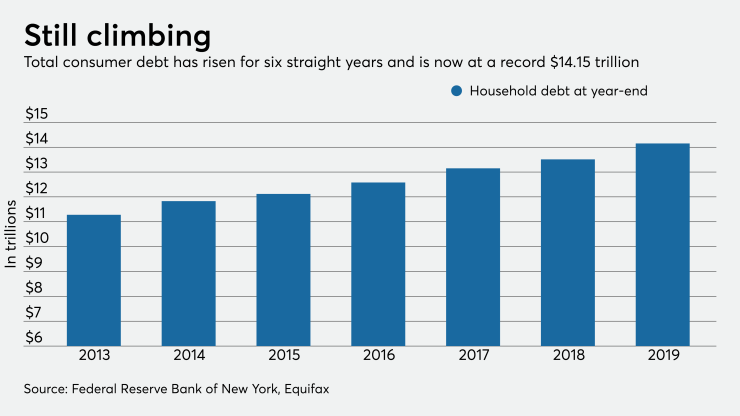U.S. household debt hit another all-time high in the fourth quarter, as outstanding balances on mortgages, student loans, auto loans and credit cards all climbed to record levels, according to data released Tuesday by the Federal Reserve Bank of New York.
Total consumer debt rose to $14.15 trillion, up nearly 5% from the end of 2018 and roughly 27% from 2013, when debt levels started rising again after years of belt-tightening.
The surge in consumer borrowing has been made possible by the longest economic expansion in the nation’s history. The U.S. unemployment rate sat at just 3.6% in January, down from nearly 10% a decade earlier.

The sustainability of the growth trend is up for debate. Some observers note that debt payments as a percentage of disposable income remain generally flat, a sign that most are living within their means.
Others worry about what will happen when the good times end and point to rising levels of auto and student loans as evidence that many borrowers are already overextended.
During the fourth quarter, U.S. mortgage originations rose by $223 billion from the previous quarter, as many homeowners used falling interest rates as an opportunity to refinance their debt.
With average on rates on a 30-year fixed-rate mortgages falling to 3.45% last week — their lowest level in three years, according to a survey by Freddie Mac — observers expect the purchase market to perk up as well.
“The combination of very low mortgage rates, a strong economy and more positive financial market sentiment all point to home purchase demand continuing to rise over the next few months,” Freddie Mac Chief Economist Sam Khater said in a press release.
On the eve of the financial crisis, mortgages represented nearly 74% of all consumer debt in the U.S., according to the New York Fed data. Today, they represent about 68% of the total.
That structural shift is largely the result of changes in the industry that have made it harder for consumers with marred credit to obtain a mortgage. In the second quarter of 2007, 52% of home loan originations went to borrowers with credit scores of 720 or higher. By the fourth quarter of last year, that number had risen to almost 80%.
Only 1.07% of mortgage balances were at least 90 days past due in the fourth quarter, according to the New York Fed data. That metric peaked at 8.89% in the first quarter of 2010.
The trends are somewhat more worrying in auto loans and student loans, the two consumer asset classes that have seen the largest growth during the post-recession period.
Balances on auto loans have risen by 84% over the last decade, and student debt has grown by 109%.
In the fourth quarter of 2019, 4.94% of auto loan balances were at least 90 days past due. It’s been more than eight years since car loan delinquencies were that high, according to the New York Fed’s data. Some 53% of auto loan originations in the quarter went to borrowers with credit scores below 720.
Delinquency rates on student loans have stayed relatively stable over the last several years, but remain much higher than they were prior to the Great Recession. In the fourth quarter of last year, 11.06% of consumer loan balances were at least 90 days delinquent, which was up slightly from the third quarter but down from the same period a year earlier.
Delinquency rates on credit card debt hit their highest level in more than four years during the fourth quarter, with 8.36% of balances classified as at least 90 days late. That rate climbed as high as 13.74% back in 2010.
Scott Anderson, the chief economist at Bank of the West, said that while consumer confidence is high, many households are stressed because real personal income is growing only modestly.
“The economic indicators … suggest there may be more trouble brewing for household spending and finances in the months ahead,” Anderson said in a research note to clients. “Our primary concern is that real personal income trends have been deteriorating for a while now and continue to miss analyst expectations, despite half-century low unemployment rates across much of the country.”
The growth in U.S. consumer debt looks less significant when in the context of wage growth and economic growth than it does in isolation.
Total consumer debt outstanding represented 65.1% of U.S. gross domestic product in the fourth quarter of 2019. That ratio was 85.5% in the third quarter of 2010.
Similarly, the ratio of households’ required debt payments to their disposable income has fallen substantially since the pre-crisis period, according to research by DBRS Morningstar.
“Overall, U.S. consumer finances are expected to remain healthy in 2020. Households are expected to keep the growth of their debt below the growth in their income,” analysts at the company wrote in a recent report.





